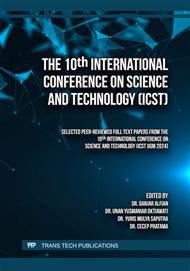[1]
PLN, "Rencana Usaha Penyediaan Tenaga Listrik (RUPTL) PT PLN (Persero) 2021-2030.," Rencana Usaha Penyediaan Tenaga List. 2021-2030, 2021, p.2019–2028.
DOI: 10.33322/energi.v10i1.330
Google Scholar
[2]
Sekretariat Jenderal Dewan Energi Nasional (DEN), Bauran Energi Nasional. 2020.
DOI: 10.21107/ilkom.v14i2.7076
Google Scholar
[3]
PT PLN (Persero), "Statistik PLN 2022," Stat. PLN, no. 03001, 2023, p.98.
Google Scholar
[4]
Pusat Kajian LKFT Universitas Gadjah Mada, Kajian Pengembangan Interkoneksi Sistem Kelistrikan Nusa Tenggara dan Potensi Energi Terbarukan. Yogyakarta, 2023.
Google Scholar
[5]
Sarjiya, L. M. Putranto, R. Irnawan, and R. F. S. Budi, "Assessing Potential Scenarios for Achieving New and Renewable Energy Targets in Java-Bali Power System, Indonesia," Int. J. Energy Econ. Policy, 2022, vol. 12, no. 2, p.502–515.
DOI: 10.32479/ijeep.12852
Google Scholar
[6]
H.T. Nguyen and F.A. Felder, "Generation expansion planning with renewable energy credit markets: A bilevel programming approach," Appl. Energy, 2020, vol. 276, no. June, p.115472.
DOI: 10.1016/j.apenergy.2020.115472
Google Scholar
[7]
D.Z. Fitiwi, M. Lynch, and V. Bertsch, "Enhanced network effects and stochastic modelling in generation expansion planning: Insights from an insular power system," Socioecon. Plann. Sci., 2020, vol. 71, no. April, p.100859.
DOI: 10.1016/j.seps.2020.100859
Google Scholar
[8]
G.S. Seck, V. Krakowski, E. Assoumou, N. Maïzi, and V. Mazauric, "Embedding power system's reliability within a long-term Energy System Optimization Model: Linking high renewable energy integration and future grid stability for France by 2050," Appl. Energy, 2020, vol. 257, no. July 2019, p.114037.
DOI: 10.1016/j.apenergy.2019.114037
Google Scholar
[9]
A.Z. Khan, S. Yingyun, and A. Ashfaq, "Generation expansion planning considering externalities for large scale integration of renewable energy," 2014 IEEE Int. Conf. Intell. Energy Power Syst. IEPS 2014 - Conf. Proc., 2014, p.135–140.
DOI: 10.1109/IEPS.2014.6874165
Google Scholar
[10]
Q. Chen, C. Kang, Q. Xia, and J. Zhong, "Power generation expansion planning model towards lowcarbon economy and its application in china," IEEE Trans. Power Syst., 2010, vol. 25, no. 2, p.1117–1125.
DOI: 10.1109/TPWRS.2009.2036925
Google Scholar
[11]
W. Shengyu, C. Lu, Y. Xiaoqing, and Y. Bo, "Long-term generation expansion planning under uncertainties and fluctuations of multi-type renewables," Int. Conf. Power Eng. Energy Electr. Drives, 2015, vol. 2015-Septe, p.612–616.
DOI: 10.1109/PowerEng.2015.7266387
Google Scholar
[12]
T. Luz, P. Moura, and A. de Almeida, "Multi-objective power generation expansion planning with high penetration of renewables," Renew. Sustain. Energy Rev., 2018, vol. 81, no. November 2016, p.2637– 2643.
DOI: 10.1016/j.rser.2017.06.069
Google Scholar
[13]
S. Pereira, P. Ferreira, and A. I. F. Vaz, "Generation expansion planning with high share of renewables of variable output," Appl. Energy, 2017, vol. 190, p.1275–1288.
DOI: 10.1016/j.apenergy.2017.01.025
Google Scholar
[14]
Y.Y. Rady, M.V. Rocco, M.A. Serag-Eldin, and E. Colombo, "Modelling for power generation sector in Developing Countries: Case of Egypt," Energy, 2018, vol. 165, p.198–209.
DOI: 10.1016/j.energy.2018.09.089
Google Scholar
[15]
E.M.F. Shinwari, "Optimization Model using WASP-IV for Pakistan's Power Plants Generation Expansion Plan," IOSR J. Electr. Electron. Eng., 2012, vol. 3, no. 2, p.39–49.
DOI: 10.9790/1676-0323949
Google Scholar
[16]
A. Malik and C. Kuba, "Power Generation Expansion Planning Including Large Scale Wind Integration: A Case Study of Oman," Wind Resour. Futur. Energy Secur., 2015, vol. 2013, p.51–68.
DOI: 10.1201/b18529-5
Google Scholar
[17]
J. G. Wright, T. Bischof-Niemz, J. R. Calitz, C. Mushwana, and R. van Heerden, "Long-term electricity sector expansion planning: A unique opportunity for a least cost energy transition in South Africa," Renew. Energy Focus, 2019, vol. 30, no. September, p.21–45.
DOI: 10.1016/j.ref.2019.02.005
Google Scholar
[18]
I. Khan, "Power generation expansion plan and sustainability in a developing country: A multi-criteria decision analysis," J. Clean. Prod., 2019, vol. 220, p.707–720.
DOI: 10.1016/j.jclepro.2019.02.161
Google Scholar
[19]
R. Shirley and D. Kammen, "Energy planning and development in Malaysian Borneo: Assessing the benefits of distributed technologies versus large scale energy mega-projects," Energy Strateg. Rev., 2015, vol. 8, p.15–29.
DOI: 10.1016/j.esr.2015.07.001
Google Scholar
[20]
K. I. Muttaqien, "Perencanaan Pengembangan Pembangkit Sistem Jawa-Bali Menggunakan Model Optimasi OSeMOSYS," Universitas Gadjah Mada, Yogyakarta, 2017.
Google Scholar
[21]
T. I. Putrisia, "Perencanaan Sistem Pembangkitan untuk Wilayah Sulawesi dengan Menggunakan OSeMOSYS," Universitas Gadjah Mada, 2017.
Google Scholar
[22]
R. F. S. Budi, "Optimasi Pengembangan Pembangkit Sistem Kelistrikan Jawa-Madura-Bali Menggunakan Game Theory : Multi-Period Framework, Bi-Level, dan Multi-Objective Optimization Method," Universitas Gadjah Mada, Yogyakarta, 2017.
Google Scholar
[23]
Tumiran, Sarjiya, L. M. Putranto, A. Priyanto, and I. Savitri, "Generation expansion planning for highpotential hydropower resources : The case of the Sulawesi electricity system," Int. J. Sustain. Energy Plan. Manag., 2020, vol. 28, no. 2, p.37–52.
DOI: 10.3390/su131810477
Google Scholar
[24]
A.A. Muthahhari et al., "Long-Term Generation Expansion Planning in Sulawesi Electricity System Considering High Share of Intermittent Renewable Energy Resource," 2019 11th Int. Conf. Inf. Technol. Electr. Eng., 2019.
DOI: 10.1109/iciteed.2019.8929948
Google Scholar
[25]
A.A. Muthahhari et al., "Environmental Considerations in Long-Term Generation Expansion Planning with Emission Limitations: An Analysis of the Sulawesi Power System in Indonesia," Proceeding - 1st FORTEI-International Conf. Electr. Eng. FORTEI-ICEE 2020, 2020, p.29–34.
DOI: 10.1109/fortei-icee50915.2020.9249863
Google Scholar
[26]
Tumiran, L.M. Putranto, Sarjiya, F.D. Wijaya, A. Priyanto, and I. Savitri, "Generation Expansion Planning Based on Local Renewable Energy Resources: A Case Study of the Isolated Ambon-Seram Power System," Sustain., 2022, vol. 14, no. 5, doi:10.3390/ su14053032.
DOI: 10.3390/su14053032
Google Scholar
[27]
Ministry of Energy and Mineral Resources; Danish Energy Agency, "Technology Data for the Indonesian Power Sector", 2021, no. February, p.1–215, [Online]. Available: https://ens.dk/sites/ens.dk/files/Globalcooperation/technology_data_for_the_indonesian_power_sector_final.pdf.
Google Scholar


